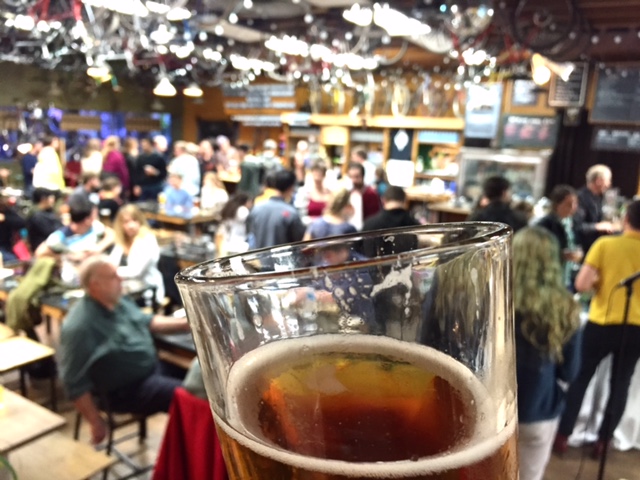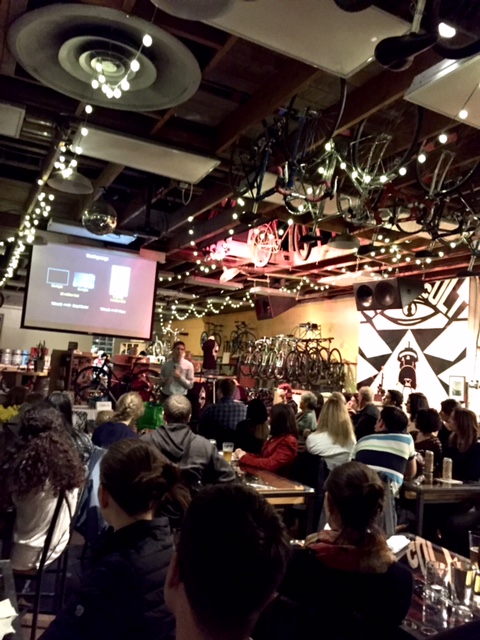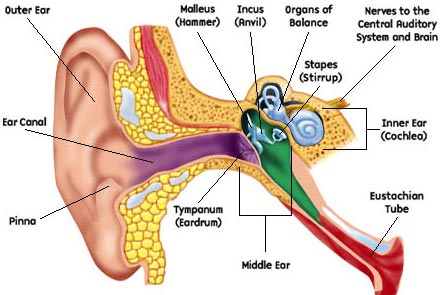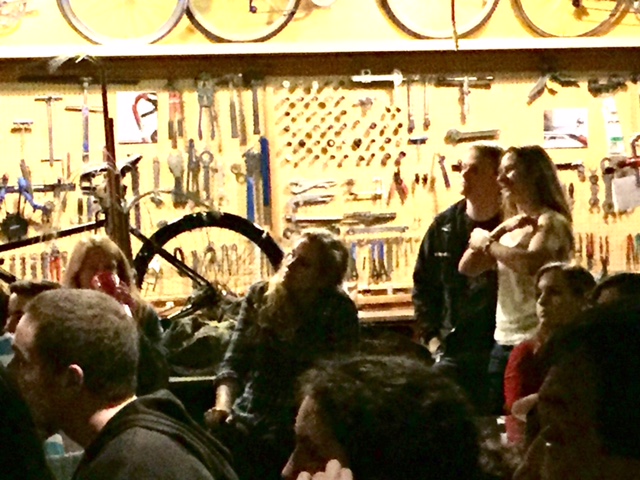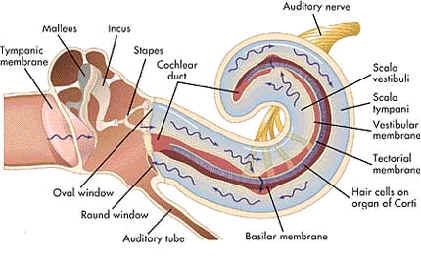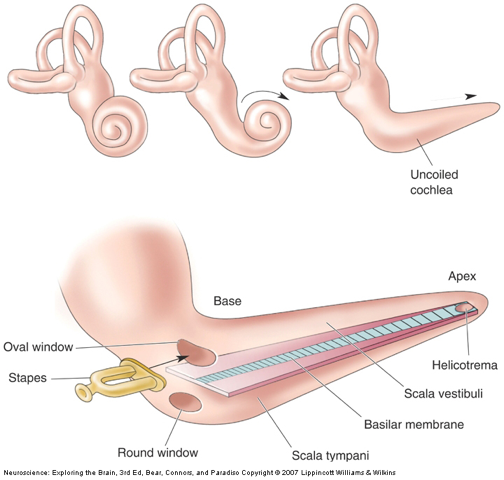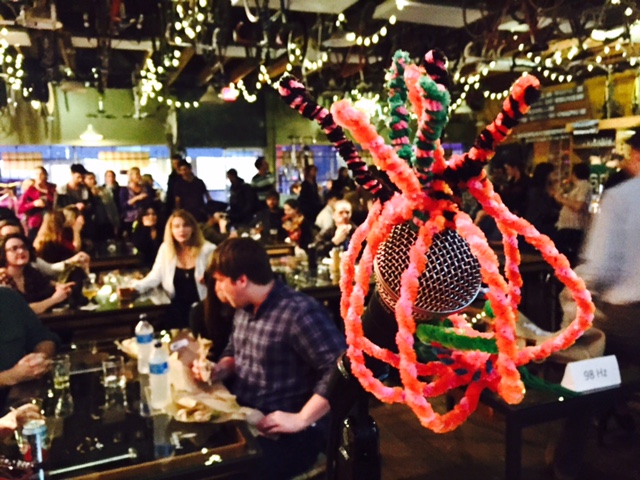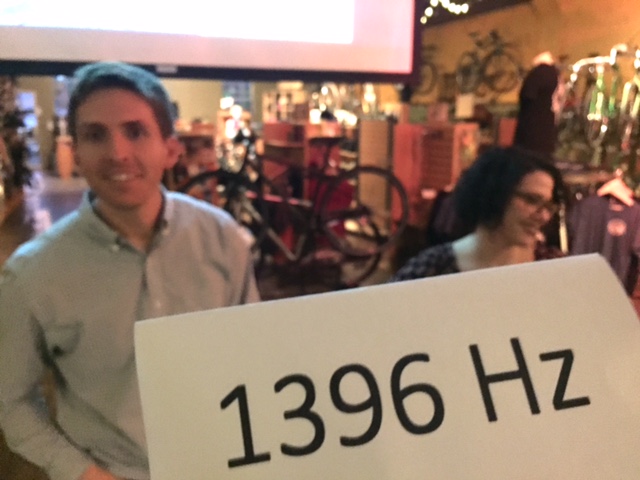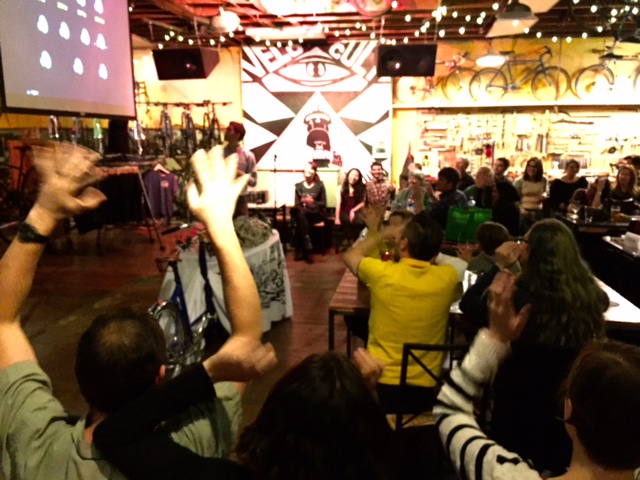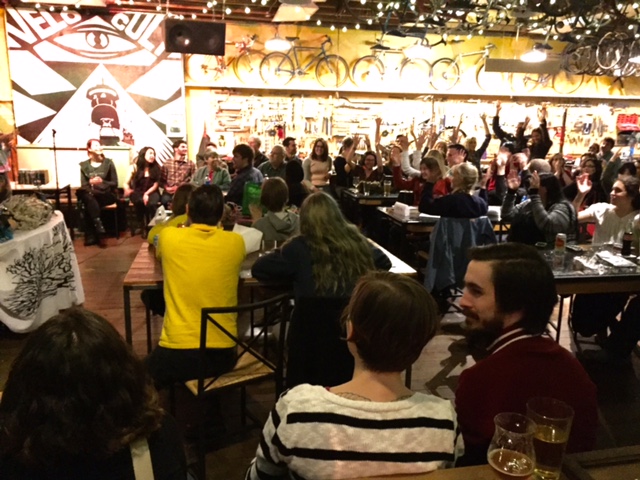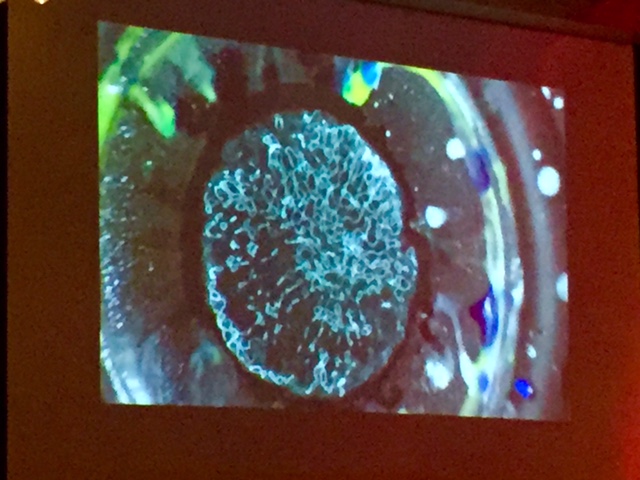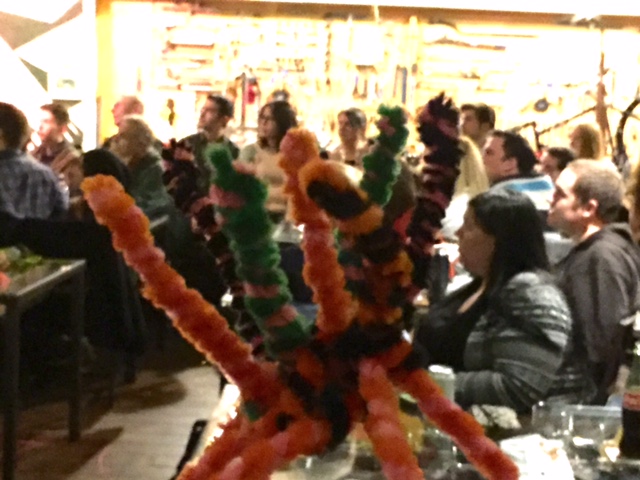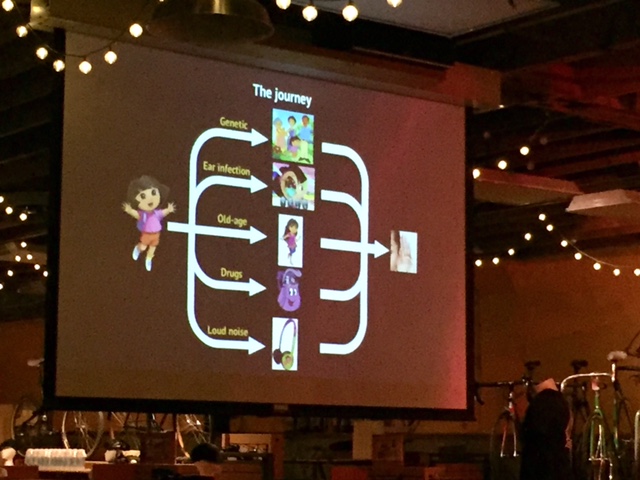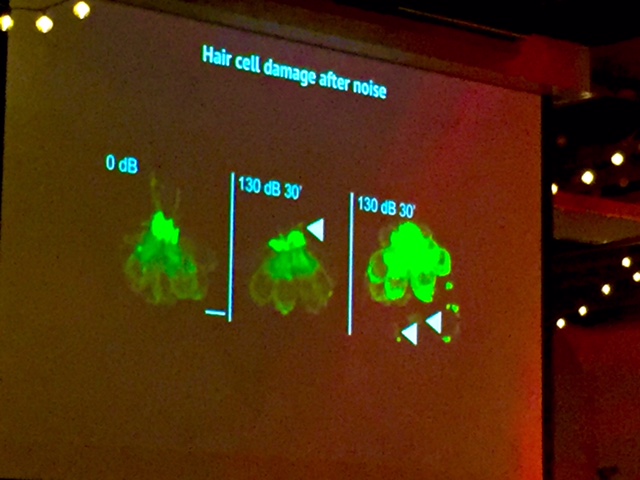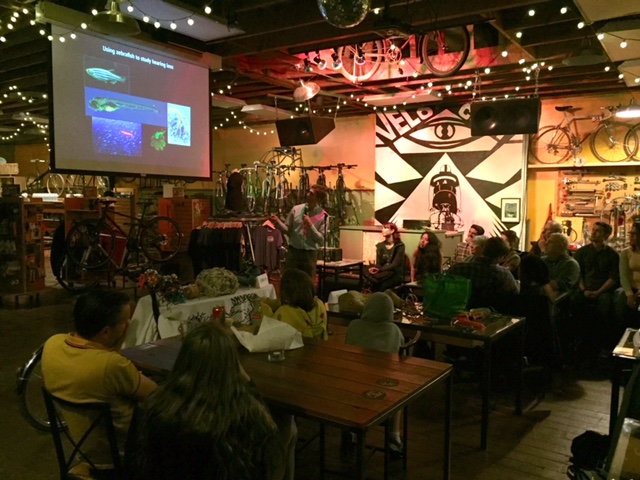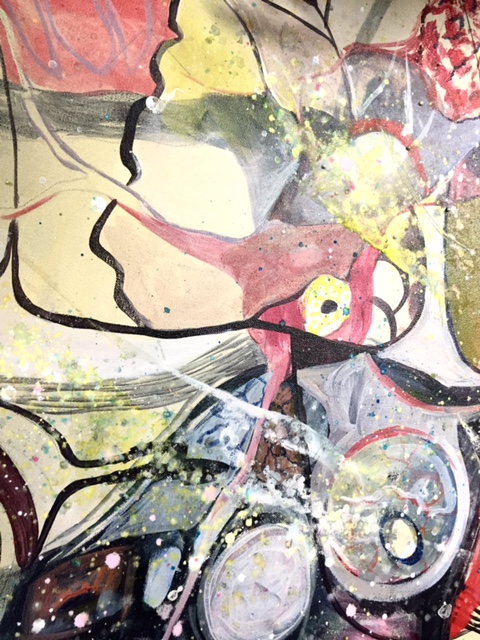It was easy to hear the large, excited crowd that gathered under the bikes at Velo Cult on Thursday evening, for a lively presentation on audition and the artistry of sound…
Phil Uribe, a graduate student in Neuroscience from WSU Vancouver, and Kimberly Cordray, an Arts Practices major from PSU, worked together to inform the audience about the physical nature of sound waves, and the delicate aural architecture that transforms this airborne vibrational energy into electrochemical signals in the inner ear…
Phil began by comparing the auditory system (clearly his favorite!) with the visual system, and noting for example how the detectable range for hearing is much, much greater than it is for sight…
In fact, explained Phil, if you express the discernible span of intensity for each sensory system in terms of distance, the range for vision, from starlight to sunlight, will take you from Velo Cult to the Lloyd Center (an easily bikeable two miles). Hearing, in contrast, would deliver you from Velo Cult…to the moon (no bikes)!
Phil next went over the structure of the ear, and explained how pressure changes in the air are captured by our “pinna,” the wing-like external projections we generally think of as our ears (or outer ears). The pinna funnel sound waves into the auditory canal, a tube extending about an inch into each side of the head. These funneled sound waves generate vibrations in a membrane at the end of each canal called the tympanic membrane, or “eardrum…”
The eardrum is attached directly to a series of three small bones known as ossicles, found in the middle ear, and ossicles move in response to the moving drum, focusing and amplifying the physical energy through the smallest ossicle (and also the smallest bone in our body) called the stapes (which is shaped like a “stirrup”).
Or, as Phil put it, that stirrup repeatedly “punches” a flexible membrane on a fluid-filled structure called the cochlea (the inner ear), converting the vibrational energy that arrived initially via air pressure changes into vibrational energy in cochlear fluid…
Inside the cochlea, or inner ear, is another membrane known as the basilar membrane, which extends through its coiled length from the base end (where the stirrup keeps punching), to its apex, or tip…
And on that basilar membrane sit the squat little sensory neurons that are essential for hearing, the hair cells, each topped by a tight cluster of swaying, hairlike projections called stereocilia. We fashioned a few (of course) out of pipe cleaners…
Phil explained that hair cells are what transform the vibrational energy of moving cochlear fluid into neural activity, and the cochlea is, remarkably, a “prism for sound.” Much as a prism breaks light into its component wavelengths, which we perceive as various colors, different areas of the basilar membrane move in response to distinct frequencies of sound, which we hear as different pitches…
The entire crowd at Velo Cult was then transformed into a basilar membrane, with us as hair cells tuned to distinct frequencies, and our arms as stereocilia waving in response to sound..!!
WATCH: Velo Cult Audience as Frequency Tuned Hair Cells video
Kim Cordray then took the stage to introduce her compelling work with pulsating speaker cones, and various fluids and objects shaken and jostled by the robust vibrational energy of sound made visible…
Her riveting work made our discussion of the “vibrational energy” of sound waves much more accessible, physical and absorbingly real…
WATCH: Kimberly Cordray Sound Wave Video clip
You can watch Kimberly’s complete video presentation below…
The Externalization of My Internal Playlist
How does one see sound? As a partnership (via NW NOGGIN) with neuroscientist/hearing loss specialist, Phil Uribe, I created a video to help visualize sound through an experimental process that involves one of my personal home speakers. By exploring the theme of hearing loss, a process was created through a personal, artistic interpretation that further investigates psychological and emotional complexities housed within the abstract world of the seen and unseen via the heard and unheard. Imagine that you are in my head as I listen to music on a commute to…………………
Directed, Produced, and Edited by Kimberly Cordray (inspired and co-directed by Jack Cook).
Phil then returned to the stage to talk about Dora the Explorer – and use that intrepid animated character to discuss hearing loss, and how hair cell loss occurs…
With Dora’s help (and apparently her backpack full of toxic chemicals…), Phil discussed genetic risks, the risk of hair cell damaging infections and drugs, the loss of hair cells with normal aging, and the reason why no one in their right mind would attend a Seahawks game at Century Link field in Seattle without earplugs…
Apparently these games are loud (up to 136 decibels!) – much louder than the level deemed safe for keeping hair cells alive. The vigorous cochlear vibrations caused by loud sounds can cause some damage quickly, but also over time, with repeated exposure – so season ticket holders are apparently at even greater risk…
And Phil is interested in protecting Seahawks fans, along with others, from killing off their hair cells and losing their ability to hear. At WSUV he studies zebra fish, small, eyelash-sized creatures with hair cells along the sides of their bodies – a much more accessible location for his research efforts than the human inner ear…
Phil has even figured out a way to take fish in water to the equivalent of a football stadium in Seattle, and expose them to sounds capable of harming hair cells. He’s tested drugs on his fish, to see if any compounds might prevent damage to their hair cells over time…
And he’s found some promising drugs, including one classified as a hepatocyte growth factor mimetic, that protect hair cells from damage due to loud noise…
Phil’s take home message was this: Zebra fish can teach us a lot about how hearing loss happens, and how to prevent it. And actual drugs potentially capable of preventing hearing loss are now in pre-clinical trials because of this exciting work…
According to Phil, perhaps someday soon those Seahawks fans might leave Century Link stadium with both a bobblehead doll – and a packet of pills to protect their hair cells, and hearing
Afterwards, audience members got to play with Kim’s speaker setup, which she placed on top of a painting she’d created, inspired by the neuron drawings of Santiago Ramon y Cajal…
A “sound” experience for all involved! Many thanks to Velo Cult, and its manager, Adam Stewart, for welcoming us to our favorite bike shop and bar…
Learn more about Phil’s research, and related work underway at WSU Vancouver Neuroscience, by clicking on the link below…





